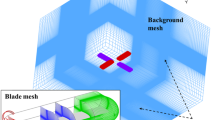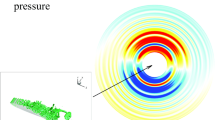Abstract
A computational study has been conducted to determine the variation of device drag with profile shape and angle of attack for aerofoil boundary-layer manipulators (LEBUs) operating at high subsonic Mach numbers. Calculations have been made at a free-stream Mach number of 0.80 for both symmetrical and asymmetrical NACA-00xx and 44xx series devices including an inverted cambered NACA-4409 profile. The LEBUs considered were located in a turbulent boundary-layer at a mid-chord heighth equivalent to 0.67δ from the wall. The present investigations sought to confirm suggestions based upon experimental observations that there may be some advantage in replacing a symmetrical device by an inverted asymmetrical profile form.
The computations were performed using an unstructured adaptive-mesh 3D Navier-Stokes code incorporating a Lam and Bremhorst low-Reynolds number two-equationk — ε turbulence model. The calculated flow field around a NACA-0009 aerofoil at zero angle of attack was initially verified against experimental interferometric data.
The calculated device drag coefficient at zero incidence was 0.026 for the NACA-0009, similar to that measured in experiments. However predicted drag for an inverted NACA-4409 was 0.085, this being considerably higher than anticipated. The results suggested that a slightly positive angle of attack may help minimise device drag but neither profile is appropriate for use in transonic conditions. Improved results may be obtained from inverted flat-topped profiles designed to minimise losses associated with localised shocks.
Similar content being viewed by others
References
Bertelrud, A., Truong, T.V. and Avellan, F., Drag reduction in turbulent boundary layers using ribbons.AIAA-82-1370 (1982).
Bonnet, J.P., Delville, J. and Lemay, J., Experimental study of the behaviour of NACA-0009 profile in transonic LEBU configuration. In:ICAS-88, Jerusalem (1988).
Bonnet, J.P., Delville, J. and Poirier, D.,Outer Manipulators in a Transonic Flow. Ellis Horwood Ltd. (1989) pp. 115–122.
Bonnet, J.P., Delville, J., Squire, L.C. and Savill, A.M.,Experiments in Fluids (1994) (submitted).
Coustols, E. and Savill, A.M., Turbulent skin friction drag reduction by active and passive means: Part 2. Technical Report 786, AGARD-FDP-VKI (1992).
Dawes, W.N, The practical application of solution-adaption to the numerical simulation of complex turbomachinery problems.Progress in Aerospace Sciences 29(3) (1992) 221–269.
Dowling, A., The effect of large-eddy break-up devices on flow noise. Unpublished report. Cambridge University Engineering Department (1990).
Goodman, W.L., Morrisetti, E.L., Hussaini, M.Y. and Bushnell, D.M., Control plate for shock boundary-layer interactions.AIAA-85-0523 (1985).
Hefner, J.N., Anders, J.B. and Bushnell, D.M., Alteration of outer flow structures for turbulent drag reduction.AIAA-83-0193 (1983).
Hefner, J.N., Wehnstein, L.M. and Bushnell, D.M., Large-eddy break-up scheme for turbulent viscous drag reduction. AIAA Paper 81-26507 (1981).
Hustad, C.-W., Squire, L.C. and Savill, A.M., Study of aerofoil LEBU at flight representative conditions by comparisons of unstructured adaptive mesh Navier-Stokes computations with experimental interferometric data.ERCOFTAC Bulletin 15 (1992) 19–21.
Hustad, C.-W. and Squire, L.C., Application of holographic interferometry for evaluation of 3D Navier-Stokes calculations.Experiments in Fluids 18 (1995) 343–350.
Lam, C.K.G. and Bremhorst, K.J., Modified form of the k-epsilon model for predicting wall turbulence.Journal of Fluids Engineering 103(3) (1981) 456–460.
Loerke, R.I. and Nagib, H.M., Experiments on the management of free stream turbulence. Technical Report 598, AGARD (1972).
McInville, R.M. and Hassan, H.A., Mixing layer control for tangential slot injection in turbulent flows.AIAA-85-0541 (1985).
Patel, V.C., Rodi, W. and Scheurer, Turbulence models for near-wall flows and low-Reynolds numbers: A review.AIAA 23(9) (1985) 1308–1319.
Plesniak, M.W. and Nagib, H.M., Net drag reduction in turbulent boundary layers resulting from optimised manipulation.AIAA-85-0518 (1985).
Savill, A.M. and Mumford, J.C., Manipulation of turbulent boundary layers by outer-layer devices: Skin-friction and flow visualization results.Journal of Fluid Mechanics 191 (1988) 389–418.
Savill, A.M., Drag reduction by passive means — A review of some recent developments. In: Gyr, A. (ed.),Proc. 2nd IUTAM Symposium on Turbulence Structures and Drag Reduction. Springer-Verlag (1989).
Trigui, N. and Guezennec, Y.G., Heat transfer reduction in a manipulated turbulent boundary layer.International Journal of Heat and Fluid Flow 11 (1990) 214.
Veuve, M., Manipulation of two-dimensional turbulent boundary layers with ribbons in tandem configuration. PhD Thesis, Ecole Polytechnique Fédérale de Lausanne (1988).
Author information
Authors and Affiliations
Rights and permissions
About this article
Cite this article
Hustad, CW., Savill, A.M. & Dawes, W.N. A numerical investigation of aerofoil boundary-layer manipulator profile for cruise-flight conditions. Appl. Sci. Res. 54, 267–280 (1995). https://doi.org/10.1007/BF00863513
Received:
Accepted:
Issue Date:
DOI: https://doi.org/10.1007/BF00863513




